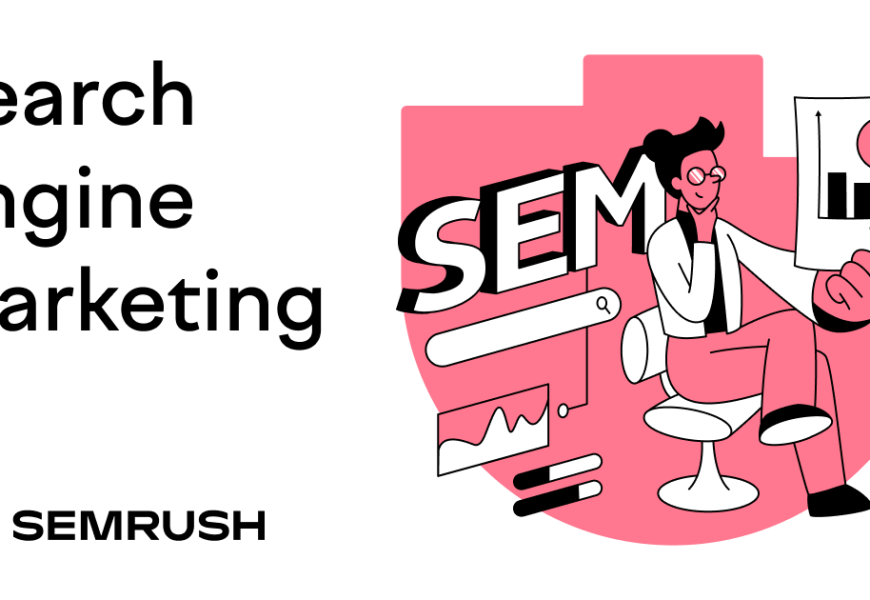Introduction
In today’s fast-paced digital world, online visibility is crucial for businesses. With more people relying on search engines to find products, services, and information, businesses that want to thrive need to ensure they can be found easily. This is where Search Engine Marketing (SEM) comes into play. SEM helps businesses stand out from competitors by reaching potential customers directly on search engines. But what exactly is SEM, and how can you leverage it for your brand’s success? This guide will break down the essentials of SEM, making it easy to understand even if you’re new to the world of digital marketing.
Basics of Search Engine Marketing
What is SEM?
Search Engine Marketing (SEM) is a digital marketing strategy that involves promoting websites by increasing their visibility in search engine results pages (SERPs) primarily through paid advertising. Unlike organic search (where traffic comes naturally through SEO-optimized content), SEM focuses on using paid advertisements to appear at the top of SERPs. When people search for specific keywords related to a business, SEM ensures that relevant ads show up prominently.
How is SEM Different from SEO?
While both SEM and SEO aim to increase visibility on search engines, their approaches differ. SEM is primarily focused on paid advertising, which provides instant results by positioning a website at the top of search pages as long as the advertiser is willing to pay for clicks. On the other hand, SEO is about optimizing content and website structure to achieve organic rankings, which can take time but is generally more sustainable in the long run. SEM and SEO are often complementary, with SEM being effective for short-term goals and SEO building a foundation for long-term traffic.
Why SEM is Important for Businesses Today
In the digital era, a strong online presence is vital for businesses of all sizes. SEM is particularly advantageous because it provides immediate visibility, which is essential for driving traffic, generating leads, and converting sales. Here are some of the main reasons SEM is important:
- Targeted Reach: SEM allows businesses to reach people actively searching for specific products or services, making it more targeted than many other forms of advertising.
- Instant Visibility: Unlike SEO, which can take months to produce results, SEM ensures that ads appear instantly in search results, as long as the advertiser is bidding on relevant keywords.
- Scalability: SEM campaigns can be adjusted based on performance, budget, and seasonal demand, allowing businesses to scale their efforts up or down as needed.
- Measurable Results: With SEM, businesses can track every aspect of their campaign performance, from clicks and impressions to conversions and ROI, making it easy to measure success.
Key Components of SEM
To set up an effective SEM strategy, it’s essential to understand the main elements involved:
- Paid Search Advertising: This is the heart of SEM, where businesses create and pay for ads to appear on search engines like Google and Bing. These ads are displayed to users searching for specific keywords, with advertisers bidding on those keywords to get their ads displayed prominently.
- Keyword Research: Keywords are the foundation of SEM. By identifying keywords relevant to their business, advertisers can ensure their ads reach people with the intent to purchase. Effective keyword research involves finding high-volume, low-competition terms to maximize ad performance.
- Bid Management: SEM platforms operate on a bidding system, where advertisers compete for ad placements. Businesses set maximum bids for keywords, indicating the most they’re willing to pay per click. Bid management tools can help automate this process by optimizing bids based on campaign performance.
- Ad Creation and Copywriting: Creating compelling ad copy is crucial for attracting clicks. Ads should be relevant, concise, and include a clear call to action. For instance, a business selling fitness equipment might use phrases like “Get Fit Today – Shop Now!”
- Performance Metrics: SEM campaigns are data-driven, and advertisers must monitor metrics like click-through rate (CTR), cost-per-click (CPC), and conversion rate to gauge campaign success and make adjustments as needed.
Step-by-Step Guide to Setting Up a SEM Campaign
Setting up a SEM campaign can be done by following a few straightforward steps:
- Set a Budget: Determine how much you are willing to spend. SEM platforms like Google Ads allow you to set a daily or monthly budget, giving you control over your spending.
- Keyword Planning: Use tools like Google Keyword Planner to find relevant keywords for your business. Focus on keywords that are both relevant and likely to drive conversions.
- Create Ads: Design ads that are eye-catching, concise, and include keywords naturally. Ads should also have a clear call-to-action, guiding users toward the desired action, such as making a purchase or signing up.
- Optimize Landing Pages: Ensure the landing page aligns with the ad’s content. If your ad promotes a specific product, the landing page should be focused on that product to maintain relevance.
- Track and Analyze: Use tools like Google Analytics to monitor your campaign’s performance. Analyzing metrics will help you understand what works and what doesn’t, allowing for ongoing optimization.
Measuring and Analyzing SEM Success
The true power of SEM lies in its data-driven approach, which makes it easy to track and analyze results. Here are some of the essential metrics for evaluating SEM performance:
- Click-Through Rate (CTR): The ratio of people who click on your ad versus those who see it. A high CTR indicates that your ad is relevant to the searcher’s intent.
- Cost-Per-Click (CPC): The average amount you pay each time someone clicks on your ad. Lowering CPC while maintaining CTR can help improve ROI.
- Conversion Rate: The percentage of users who complete a desired action, like purchasing a product or signing up. Optimizing conversion rates is key to SEM success.
- Return on Investment (ROI): SEM allows you to calculate ROI directly, comparing the amount spent on ads to the revenue generated from clicks and conversions. This makes it easy to assess whether your SEM campaigns are profitable.
Resources to Learn SEM
Whether you’re a beginner or an experienced marketer, numerous resources can help you master SEM. Many online platforms offer search engine marketing course that cover everything from the basics of ad creation to advanced bid management strategies. These courses provide hands-on learning opportunities, allowing you to build your skills and become confident in SEM practices.
Some popular platforms for SEM education include:
- Google Skillshop: Google’s own learning platform offers free courses and certifications in Google Ads, a key tool in SEM.
- LinkedIn Learning: With a range of beginner to advanced courses, LinkedIn Learning provides SEM training from top industry experts.
- HubSpot Academy: HubSpot offers a variety of digital marketing courses, including those focusing on SEM principles.
- Udemy: This platform provides courses taught by experts worldwide, covering SEM for all skill levels.
By enrolling in one of these courses, you can gain a comprehensive understanding of SEM and develop the skills needed to launch and optimize successful campaigns.
Conclusion
Search Engine Marketing is a powerful tool that can elevate a business’s online visibility, drive traffic, and increase sales. With the right approach, SEM can help businesses reach potential customers at the perfect moment—when they’re actively searching for related products or services. While SEM requires an understanding of keywords, bidding, ad copy, and analytics, there are many resources and courses available to help marketers and business owners gain the skills they need.
Whether you’re looking to attract local customers or expand your business internationally, SEM can be tailored to your unique goals. Embracing SEM as part of a comprehensive marketing strategy can bring immediate visibility and lasting success. Now that you understand the basics, you’re ready to explore the world of SEM and harness its potential to achieve your business objectives.











